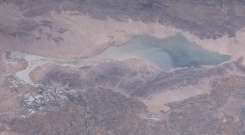Laguna Salada (Mexico)
| Laguna Salada | |
|---|---|
 | |
| Location |
Sonoran Desert Mexicali Municipality, Baja California |
| Coordinates | 32°21′41″N 115°39′18″W / 32.3614°N 115.6551°WCoordinates: 32°21′41″N 115°39′18″W / 32.3614°N 115.6551°W |
| Lake type | Endorheic basin |
| Primary inflows | rain dependent |
| Primary outflows | Terminal (evaporation) |
| Basin countries | Mexico |
| Max. length | 60 km (37 mi) |
| Max. width | 17 km (11 mi) |
| Shore length1 | 250 km (160 mi) |
| 1 Shore length is not a well-defined measure. | |
Laguna Salada is a vast dry lake some 10 meters below sea level (sometimes wet - sometimes dry) in the Sonoran Desert of Baja California, 30 km (19 mi) southwest of Mexicali.[1] The lake's shape vaguely resembles a rhombus. When dry, the flatness of the exposed lake bed sediments makes it a favoured location for recreational driving. It is also notorious for its dust storms (when dry), usually the result of monsoonal thunderstorms during the summer. During times of significant rain the lagoon can fill completely with water, leaving the unpaved road along its west bank as the only means of traversing the area. Flanked by the Sierra de Los Cucapah and the Sierra de Juárez mountain ranges, the lake is approximately 60 km (37 mi) long and 17 km (11 mi) at its widest point.
Tectonic activity
The lake itself is located on the bottom of a shallow depression, a graben, which is linked to the San Andreas Fault, and the East Pacific Rise as part of the Laguna Salada Fault. This fault is connected to the Salton Trough fault which holds a similar depression, the Salton Sink. This sink is bigger than Laguna Salada and contains the Salton Sea.[2] The 2010 Baja California earthquake occurred here.
References
- ↑ "Land Below Sea Level". By David K. Lynch, Thule Scientific.
- ↑ "Geology of the Salton Trough" (PDF). David L. Alles, Western Washington University.
- Carlos Fiesta. Ocean Odyssey. Palos Verdes Estates, California: Mexico Expo Travel. Retrieved 2009-09-17.
- Becky Dorsey (2003). "Pleistocene to Holocene Laguna Salada". University of Oregon. Retrieved 2009-09-17.
- G Jimenez; et al. (2000). "Preliminary Study of the Fishery in Laguna Salada, Baja California". University of San Diego. Retrieved 2009-09-17.
External links
- Satellite Photo (Google Maps)
- Vol. 44, Num. 1, pp. 103-111, A technical paper by Juan Contreras, Arturo Martín-Barajas and Juan Carlos Herguera on sedimentation of the LS-basin. Published in Geofísica Internacional (2005)